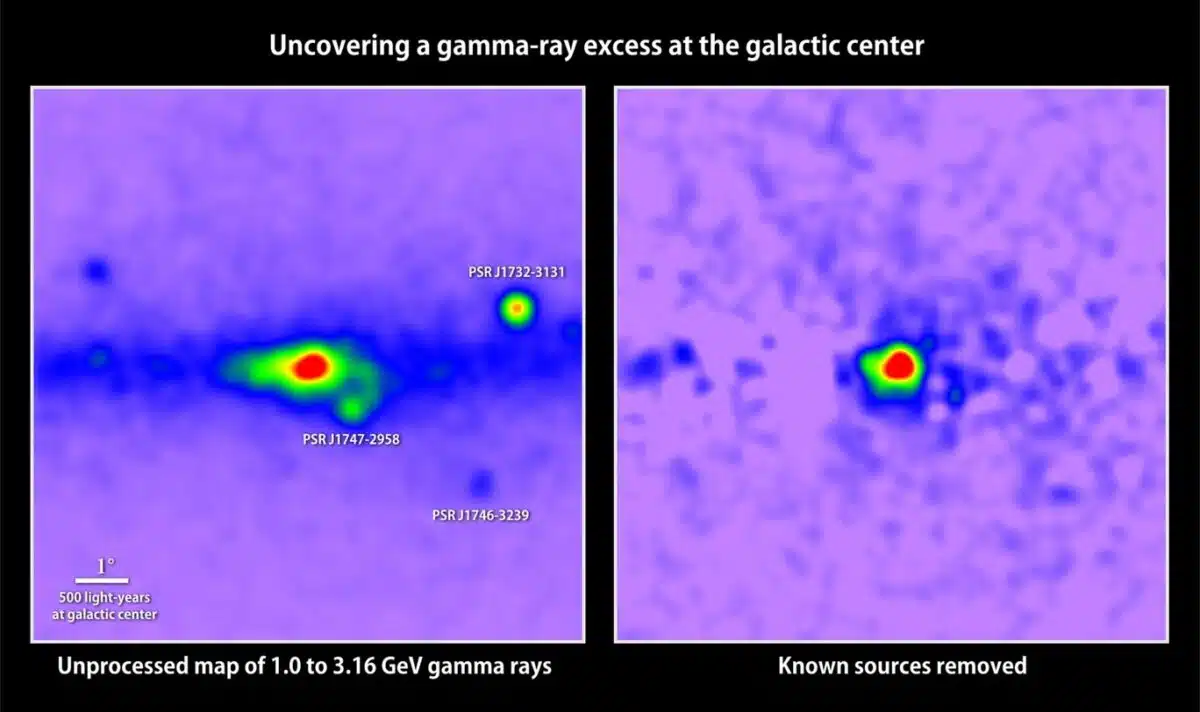For over a decade, the Fermi Gamma-Ray Space Telescope has mapped a mysterious excess of gamma-ray light in the inner regions of the Milky Way. This unusual glow spans thousands of light-years and doesn’t align with any known sources. As a result, astronomers have been left with two major possibilities: the light could be the signature of dark matter, the invisible substance that makes up most of the universe’s mass, or it could come from a dense concentration of pulsars, rapidly spinning remnants of dead stars.
A new study published in Physical Review Letters brings both ideas into sharper focus, showing that either could explain the phenomenon, but crucial differences remain that could lead to one theory emerging as the winner.
Dark Matter: A Hidden Force at Play?
Dark matter has long been a mysterious and elusive force in the universe, detectable only through its gravitational effects on visible matter. According to Moorits Mihkel Muru, an astrophysicist at the Leibniz Institute for Astrophysics Potsdam, recent simulations suggest that dark matter could be behind the unusual gamma-ray signal.
Muru’s team modeled Milky Way-like galaxies and found that the shape of the galaxy’s dark matter halo, which is skewed due to past galaxy mergers, could create the specific gamma-ray pattern observed by Fermi.
As the research points out, dark matter doesn’t emit or block light, so finding a way to trace its presence through gamma-rays would be a groundbreaking discovery in astrophysics. However, while the dark matter theory is compelling, Muru stresses that it’s not conclusive, and the exact nature of dark matter’s interaction with visible matter remains unknown.
 Gamma-ray excess at the Milky Way’s center, with known sources removed to reveal a mysterious signal. Credit: Stanford University
Gamma-ray excess at the Milky Way’s center, with known sources removed to reveal a mysterious signal. Credit: Stanford University
Pulsars: Could a Swarm of Stars Be the Cause?
Pulsars are known to produce high-energy gamma-rays, but the problem with this theory is that current observations suggest there aren’t enough pulsars in the Milky Way’s core to explain the intensity and spread of the gamma-ray burst. If pulsars are the cause, astronomers would expect to see numerous individual sources of gamma-rays, rather than the smooth, uniform glow that has been detected.
Muru’s study suggests that pulsars could still be a viable explanation, but only if far more pulsars exist in the galactic core than currently detected. The problem, however, is that the number of known pulsars in this region falls far short of what would be needed to account for the gamma-ray light. If pulsars are indeed the source, their distribution would likely form clusters of points, not the smooth, extended pattern observed.
 Gamma-ray maps of the Milky Way’s center showing different models for the mysterious glow. Credit: arXiv
Gamma-ray maps of the Milky Way’s center showing different models for the mysterious glow. Credit: arXiv
Testing the Theories: The Role of the Cherenkov Telescope Array
To settle the debate between dark matter and pulsars, astronomers are turning to the upcoming Cherenkov Telescope Array Observatory (CTAO). Set to provide sharper images of high-energy gamma-rays than any current technology, the CTAO will allow researchers to observe the gamma-ray glow with unprecedented detail.
This enhanced resolution could provide crucial information about the light’s distribution, helping to determine whether the glow is smooth.
Muru’s team emphasizes that this kind of data will be critical in distinguishing between the two competing ideas. With the CTAO poised to provide this much-needed clarity, astronomers are hopeful that the mystery of the Milky Way’s gamma-ray burst will soon be solved.

